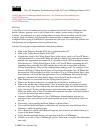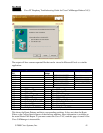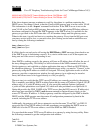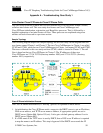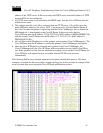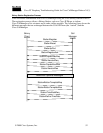
Cisco IP Telephony Troubleshooting Guide for Cisco CallManager Release 3.0(1)
© 2000 Cisco Systems, Inc. 45
00:00:22:480 (CFG) DHCP Timeout Waiting on Server, DHCPState = INIT
00:00:38:480 (CFG) DHCP Timeout Waiting on Server, DHCPState = INIT
If the above timeout message continues to scroll by, then there is a problem contacting the
DHCP server. First thing to check is that the Catalyst 6000 gateway port is in the correct VLAN.
This information is in the ‘sh port’ command from before. If the DHCP server is not on the
same VLAN as the Catalyst 6000 gateway, then make sure the appropriate IP Helper addresses
have been configured to forward the DHCP requests to the DHCP server. It is possible for the
gateway to get stuck in the INIT state after a VLAN number change until the gateway resets.
When in this state, it would not hurt to try resetting the gateway. Every time the 860 gets reset,
your tracy session will be lost, so you must close your existing session and re-establish a new
one by issuing the following commands:
tracy_close mod port
tracy_start mod port
If all this checks out and you're still seeing the DHCPState = INIT messages, then check to see
if the DHCP server is functioning correctly. If so, start a sniffer trace to see if the requests are
being sent and if the server is responding or not.
Once DHCP is working correctly, the gateway will have an IP address that will allow the use of
the tracy debugging utility. This utility is a built-in feature of the NMP command set for the
Catalyst gateways, and available as a helper application that runs on Windows 98/NT/2000 for
the standalone gateways. To use the helper application tracy utility, you need to "Connect" to the
gateway by using the IP address to which it is assigned. This tracy application works on all the
gateways, provides a separate trace window for each gateway (up to eight may be traced at
once), and allows traces to be logged directly to a file you specify.
The next step is to verify that the TFTP server IP address was correctly provided to the gateway.
This is normally provided by DHCP in either Option 66 (by name or IP address), Option 150 (IP
address only), or si_addr (IP address only). If your server has multiple Options configured,
si_addr will take precedence over Option 150, which will take precedence over Option 66. If
Option 66 provides the DNS_NAME of the TFTP server, then the DNS server(s) IP address(es)
must have been specified by DHCP, and the name entered in Option 66 must resolve to the
correct TFTP server IP address. A Catalyst gateway could be configured by the NMP to disable
DHCP, and the NMP operator must then enter all configuration parameters by hand at the
console, including the TFTP server address.
Additionally, the gateways will always attempt to resolve the name "CiscoCM1" via DNS. If
successful, the CiscoCM1 IP address will take precedence over anything the DHCP server or
NMP tells it for the TFTP server address, even if the NMP has DHCP disabled.
You can check the current TFTP server IP address in a gateway by using the tracy utility. Enter
the following command to get the configuration task number:
TaskID: 0
Cmd: show tl



